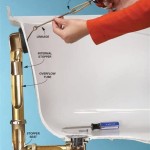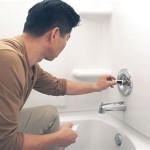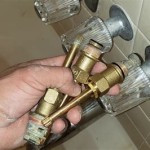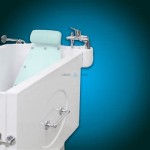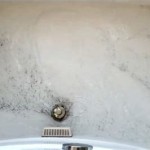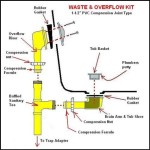How To Unclog A Bathtub Drain Without Baking Soda
A clogged bathtub drain is a common household issue, often resulting from the accumulation of hair, soap scum, and other debris. While many solutions involve baking soda, there are alternative methods available for addressing this plumbing problem. This article outlines several techniques for unclogging a bathtub drain without relying on baking soda, providing a comprehensive guide for homeowners.
Before attempting any unclogging method, it is essential to assess the severity of the clog. Minor clogs might be resolved with simpler techniques, whereas more stubborn blockages might necessitate more rigorous approaches. Visual inspection of the drain opening can help determine if any large, easily removable debris is present. Additionally, observing the rate at which water drains (or fails to drain) provides an indication of the clog's intensity.
Plunger Application
A plunger is a basic yet effective tool for dislodging bathtub drain clogs. The most common type is a cup plunger, designed for flat surfaces like bathtub floors. Flange plungers, which have a soft rubber flap that folds out from the cup, are better suited for toilets but can still be used effectively in bathtubs by folding the flange back into the cup.
Before using the plunger, remove the drain stopper if possible. This allows for a more direct application of suction. If the stopper cannot be removed, ensure it is in the open position. Add enough water to the bathtub to cover the cup of the plunger completely. This ensures a tight seal and maximizes the pressure created by the plunging action.
Position the plunger directly over the drain opening, ensuring a complete seal. Push and pull the plunger up and down with a firm, steady motion. Avoid lifting the plunger completely off the drain surface during each stroke, as this breaks the seal and reduces the effectiveness. Continue plunging for several minutes, pausing occasionally to check if the water is draining. If the water begins to drain, continue plunging to fully clear the clog.
If the initial plunging attempts are unsuccessful, try adding a small amount of petroleum jelly to the rim of the plunger cup to improve the seal. Additionally, ensure that the overflow drain (the small hole near the top of the bathtub) is covered with a wet cloth or duct tape. This prevents air from escaping and helps maintain suction.
Hot Water Flush
In some cases, a simple flush with hot water can dissolve or dislodge minor clogs, particularly those composed of soap scum or grease. This method is most effective when the clog is located relatively close to the drain opening.
First, remove any standing water from the bathtub. Then, carefully pour a kettle or pot of hot (but not boiling) water directly down the drain. Boiling water can potentially damage some types of pipes, especially PVC pipes. Allow the hot water to sit in the drain for several minutes to break down the clog.
After letting the water sit, run the bathtub faucet to see if the drain is flowing more freely. If the clog persists, repeat the hot water flush several times. Increasing the water pressure by using a strong stream from the faucet can also aid in dislodging the blockage.
It's important to exercise caution when handling hot water to prevent burns. Use gloves and a pot holder to protect hands, and avoid splashing the hot water onto skin or eyes. Furthermore, be mindful of the type of plumbing in the home. Older pipes may be more susceptible to damage from extreme temperature changes.
Wire Hanger or Drain Snake Utilization
When a clog resists plunging and hot water flushes, a more direct approach is often necessary. A straightened wire hanger or a drain snake (also known as an auger) can be used to physically break up and remove the blockage.
If using a wire hanger, straighten it as much as possible, leaving a small hook at the end. Carefully insert the hooked end of the hanger into the drain opening. Gently probe around inside the drain, attempting to hook and pull out any debris. Avoid pushing the clog further down the drain, as this can worsen the problem. Periodically remove the hanger and clean off any accumulated hair or debris.
A drain snake is a more specialized tool designed specifically for unclogging drains. It consists of a flexible metal cable with a corkscrew-like tip. Insert the drain snake into the drain opening and rotate the handle to feed the cable further down the drain. When resistance is encountered, continue rotating the handle to break up or snag the clog.
Once the clog has been broken up or snagged, carefully retract the drain snake, pulling out any debris. Clean the drain snake thoroughly after each use. Running water down the drain after removing the debris will help flush out any remaining fragments. Repeat the process as needed until the drain flows freely.
When using either a wire hanger or a drain snake, exercise caution to avoid scratching or damaging the bathtub's finish. Use gentle movements and avoid excessive force. If resistance is too strong, it may indicate that the clog is too large or located too far down the drain, requiring professional assistance.
Wet/Dry Vacuum Application
A wet/dry vacuum can be used to create suction to pull clogs out of a bathtub drain. This method is particularly effective for clogs that are close to the drain opening and not deeply embedded within the pipes.
Begin by setting the wet/dry vacuum to its liquid setting and emptying the canister. Remove the drain stopper, if possible. If the stopper cannot be removed, ensure it is in the open position. Create a tight seal between the vacuum hose and the drain opening using a rag or duct tape. This helps maximize the suction force.
Turn on the vacuum and let it run for several minutes. The suction created by the vacuum should pull the clog up and into the canister. Periodically turn off the vacuum and check the hose and canister for any accumulated debris. Remove the debris and continue the process until the drain is clear.
If the wet/dry vacuum is ineffective, try adding a small amount of water to the bathtub to help loosen the clog. The water will also help to create a better seal between the vacuum hose and the drain opening. Be careful not to overfill the bathtub, as this can cause the vacuum to become overwhelmed.
Dish Soap and Hot Water Combination
Dish soap, particularly formulations designed to cut through grease, can be a helpful tool in dissolving certain types of bathtub drain clogs. This method works best on clogs composed primarily of soap scum, grease, or hair products.
First, remove any standing water from the bathtub. Pour approximately one-quarter to one-half cup of dish soap directly down the drain. Allow the dish soap to sit in the drain for 15-30 minutes to break down the clog. Follow this with a flush of hot (but not boiling) water, as described previously. The hot water helps to further dissolve the clog and flush it away.
Monitor the drain to see if the water is flowing more freely. If the clog persists, repeat the dish soap and hot water treatment several times. Employing the plunger after this method can also assist in dislodging remaining debris. The dish soap acts as a lubricant, making it easier for the plunger to create a seal and generate pressure.
Enzyme Drain Cleaners
Enzyme drain cleaners offer a more environmentally friendly alternative to chemical drain cleaners. These cleaners contain enzymes that break down organic matter, such as hair, soap scum, and grease, without harming pipes or the environment.
Follow the instructions on the enzyme drain cleaner product label carefully. Typically, this involves pouring a specified amount of the cleaner down the drain and allowing it to sit for several hours or overnight. The enzymes need time to work on the clog. After the recommended waiting period, flush the drain with hot water to clear away any remaining debris.
Enzyme drain cleaners are most effective when used regularly as a preventative measure. Regular application can help prevent clogs from forming in the first place. Unlike chemical drain cleaners, enzyme drain cleaners do not generate heat or harmful fumes, making them a safer option for homes with children or pets.
It is important to note that enzyme drain cleaners may not be effective on all types of clogs. They work best on organic matter and may not be able to dissolve mineral deposits or solid objects. In such cases, other unclogging methods may be necessary.
Preventative Maintenance
Preventing clogs is always easier than clearing them. Implementing preventative maintenance measures can significantly reduce the frequency of bathtub drain clogs.
One of the most effective preventative measures is installing a drain strainer or screen. These devices catch hair and other debris before they enter the drainpipe. Regularly cleaning the strainer is essential to prevent it from becoming clogged itself. Ideally, the strainer should be cleaned after each shower or bath.
Flushing the drain with hot water after each use can also help prevent the buildup of soap scum and grease. Periodically pouring a solution of white vinegar and hot water down the drain can also help to dissolve mineral deposits and keep the drain flowing freely.
Avoid pouring oil, grease, or food scraps down the bathtub drain. These materials can solidify and cause significant clogs. Instead, dispose of these items properly in the trash or garbage disposal (if applicable and appropriately designed for grease disposal).
By implementing these preventative maintenance measures, homeowners can significantly reduce the risk of bathtub drain clogs and avoid the need for frequent unclogging procedures.

5 Easy Ways To Unclog Bathtub Drain

How To Unclog A Drain With Baking Soda Vinegar The Art Of Manliness

How To Easily Unclog Bathtub Shower Drain In 5 Minutes Jonny Diy

3 Simple Ways To Unclog A Bathtub Drain Naturally Wikihow

How To Unclog A Bathtub Drain Without Chemicals Family Handyman

How To Unclog A Bathtub Drain Without Chemicals

How To Unclog A Bathtub Drain Without Chemicals Family Handyman

How To Easily Unclog A Drain Without Harsh Chemicals Baking Soda Vinegar

How To Unclog A Bathtub Drain Without Chemicals

How To Unclog A Bathtub Drain 11 Diy Clog Busters

